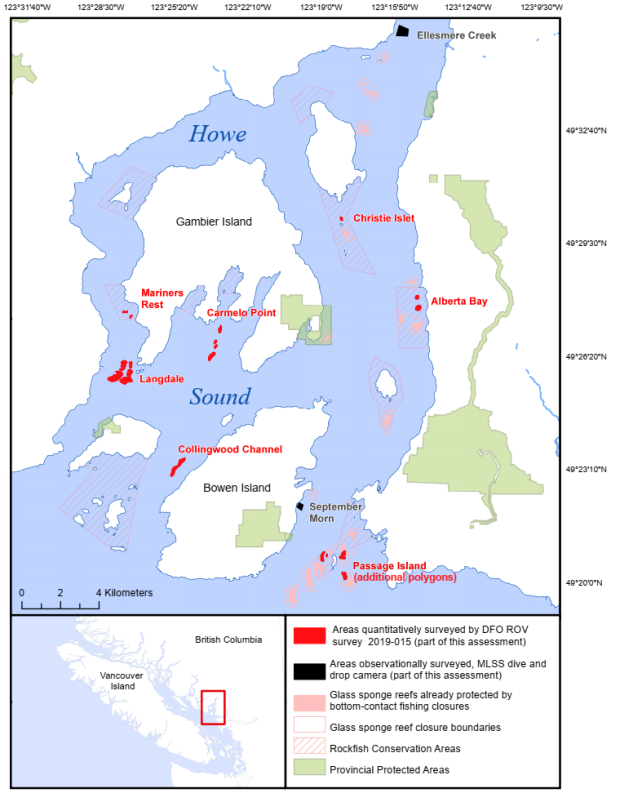Five new living glass sponge reefs have been identified and confirmed by Fisheries and Oceans Canada (DFO) in the Howe Sound area, including a large reef just off the Langdale ferry terminal.
The Langdale reef, as it is described in a DFO “ground-truthing” report that assessed the new reefs, is situated between the Langdale ferry terminal and Gambier Harbour, along the ferry route connecting the Sunshine Coast with Horseshoe Bay, surveyed at a depth of between 30 and 92 metres.
It’s home to expansive areas of live reef habitat “with many tall, tube-like” cloud sea sponges, according to the report, titled Science Response: Ground-truthing Suspected Howe Sound Sponge Reefs.
DFO said ferry traffic “is not expected to pose a risk” to the reef, given its depth.
Graham Starsage, a scientific SCUBA diver for the Nicholas Sonntag Marine Education Centre in Gibsons, is one of the few people in the world who dives around glass sponges – though not yet at the sites just identified.
The reefs are “entire underwater cities that are teaming with life,” he said.
“It’s breathtaking, they’re so beautiful… There’s a whole plethora of rockfish that live down there.”
Given the location of the Langdale reef, the report suggests developing onboard “information packages” for ferry passengers, such as videos or posters featuring the reef, to “raise public awareness of B.C.’s unique glass sponge reefs which in turn may improve stakeholder acceptance and compliance with spatial management measures.”
Starsage said the Sonntag Centre, which has partnered with DFO and BC Ferries, is open to assisting with any potential education. “We’re here to connect people to the ocean and teach them about what’s right in Howe Sound,” he said.
Four other areas assigned live reef status are: Carmelo Point off south Gambier Island, Collingwood Channel between Keats and Bowen islands, Mariners Rest on the west side of Gambier, and Alberta Bay near Lions Bay. A site near Passage Island within an existing reef complex was deemed “likely” dead, though the report said there is a possibility of future recovery.
While common more than 200 million years ago, today glass sponge reefs are only found in a few locations off the Pacific coast of Canada and the United States. The deep-water filter-feeding animals have skeletons made of silica.
Glass sponge reefs can remove organic carbon at rates similar to kelp forests and old growth forests, according to the DFO report.
Between 2015 and 2016 DFO closed nine areas to fishing to protect glass sponge reefs and in April 2019 closed an additional eight.
Nine of the reefs in Howe Sound cover approximately six sq. kilometres and process 17 billion litres of water each day, according to the report.
The five newly identified living reefs cover 11 sq. kilometres. The report’s authors estimate the new reefs have a similar capacity for filtration, “considerably increasing previous total estimates for Howe Sound.”
In an email response to Coast Reporter, DFO said the process to confirm the status of the reefs was undertaken following the April 2019 closures.
None of the five new reefs are directly protected and are considered “extremely sensitive to physical disturbances.”
Glass sponge reefs grow between one and nine centimetres a year and are exceptionally fragile, with some living more than 220 years. Because of that, recovery rates are low if the reefs are disturbed, the report said.
Researchers found detritus impacting the reefs such as drag lines, including at Carmelo Point, where crab traps, rope and other fishing gear were found.
The reef at Carmelo Point is situated in a Rockfish Conservation Area, but that doesn’t stop other forms of commercial or recreational fishing.
Several fish of economic importance also inhabit the reefs, including rockfish, lingcod and spot prawns.
The B.C. chapter of Canadian Parks and Wilderness Society (CPAWS) has called for the “urgent” establishment of the reefs as Marine Protected Areas under the Oceans Act, which would regulate activity that could damage the reefs.
“Marine protected areas will not only protect glass sponge reefs from physical damage caused by bottom-contact fishing, they will also act as natural climate solutions,” said CPAWS-BC ocean conservation manager Ross Jameson in a release calling for protection.
CPAWS made its call on the heels of the newly verified reefs and a recent peer-reviewed study from UBC indicating that ocean acidification and warming poses “a serious and immediate threat” to the kinds of glass sponge reefs situated in Howe Sound.
DFO told Coast Reporter “any decisions on future protection of these sites will be guided by DFO policies and legislation, including DFO’s Policy for Managing the Impacts of Fishing on Sensitive Benthic Areas, and will take into account conservation objectives, an ecosystem approach, socio-economic considerations, and the views and interests of Indigenous groups, commercial and recreational harvesters, and other interested groups.”




